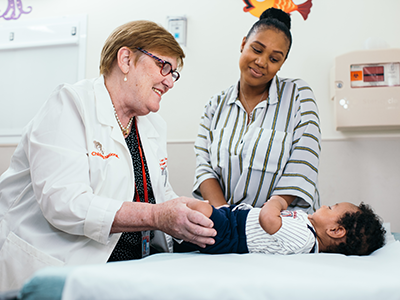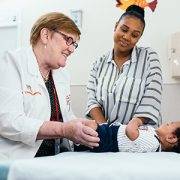Building patient-centered outcomes research in osteogenesis imperfecta

Children’s orthopaedic surgeon Laura Tosi, M.D., is the co-lead on a program to improve patient-centered outcomes research and education in osteogenesis imperfecta that recently received a Eugene Washington Engagement Award of $250,000 from the Patient-Centered Outcomes and Research Institute (PCORI).
Children’s orthopaedic surgeon Laura Tosi, M.D., is the co-lead on a program to improve patient-centered outcomes research and education in osteogenesis imperfecta (OI) that recently received a Eugene Washington Engagement Award of $250,000 from the Patient-Centered Outcomes and Research Institute (PCORI). Dr. Tosi serves as project co-lead alongside colleagues Tracy Hart, project lead, from the Osteogenesis Imperfecta Foundation (OIF) and Bryce Reeve, Ph.D., co-project lead, director of the Center for Health Measurement at Duke University.
The project, which will be housed at the Osteogenesis Imperfecta Foundation, will run for two years and seeks to:
- Create a community of stakeholders (patients/caregivers/clinicians/researchers) who are trained or training in patient-centered outcomes research, with specific attention to priority topics identified by the OI community.
- Expand communications and education strategies related to patient-centered outcomes research to enhance the care of the OI community.
- Establish and extend the capacity among patients, caregivers, clinicians and researchers in OI to participate in both patient-centered outcomes research and comparative effectiveness activities.
- Develop an OI-specific toolkit focused on disseminating evidence-based clinical care recommendations to stakeholders and care providers, based on sustainable input from the OI community.
- Extended the reach of these activities to support other rate bone disease communities.
Osteogenesis imperfecta is a group of genetic disorders causing connective tissue dysfunction and bone fragility. It is the most common of nearly 450 rare skeletal disorders and affects an estimated 25,000 to 50,000 people in the U.S. Collecting the patient’s perspective about natural history, clinical best practices, quality of life and research priorities is challenging because, like so many rare diseases, the affected population is relatively small and geographically dispersed.
“We hope this project will give us the ability to develop a set of best practices for care and research based on research that incorporates the patient’s point-of-view,” says Dr. Tosi. “I’m excited to work with this team and begin to change how we think about and care for OI patients and their families.”



